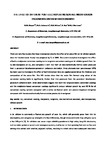The effect of different post-electroplating surface modification treatments on tin whisker growth
| dc.contributor.author | Haspel, DM | en |
| dc.contributor.author | Ashworth, MA | en |
| dc.contributor.author | Wilcox, GD | en |
| dc.contributor.author | Bao, X | en |
| dc.contributor.author | Mortimer, RJ | en |
| dc.date.accessioned | 2019-05-13T08:40:06Z | |
| dc.date.available | 2019-05-13T08:40:06Z | |
| dc.date.issued | 2019-05-04 | en |
| dc.identifier.issn | 0020-2967 | en |
| dc.identifier.uri | http://hdl.handle.net/10026.1/13842 | |
| dc.description.abstract |
There are very few studies that have investigated directly the effect of an oxide film on tin whisker growth, since the ‘cracked oxide theory’ was proposed by Tu in 1994. The current study has investigated the effect of both a molybdate conversion coating and a tungstate conversion coating on tin whisker growth from Sn–Cu electrodeposits on Cu, and compared it with that from an electrochemically formed oxide produced from a potassium bicarbonate-potassium carbonate electrolyte. X-ray photoelectron spectroscopy (XPS) has been used to investigate the effect of both immersion time and applied potential on the thickness and composition of the oxide film. The XPS studies show that the oxide film formed using either of the conversion coating baths is significantly thicker than that produced from the potassium bicarbonate-potassium carbonate bath. Initial observations suggest that both the tungstate-based conversion coatings and the molybdate-based conversion coatings significantly reduce whisker growth by over 80% for all conversion coating systems compared with a native air-formed oxide and provide improved mitigation compared with the electrochemically formed oxides previously investigated. | en |
| dc.format.extent | 129 - 139 | en |
| dc.language.iso | en | en |
| dc.title | The effect of different post-electroplating surface modification treatments on tin whisker growth | en |
| dc.type | Journal Article | |
| plymouth.issue | 3 | en |
| plymouth.volume | 97 | en |
| plymouth.publication-status | Published | en |
| plymouth.journal | Transactions of the Institute of Metal Finishing | en |
| dc.identifier.doi | 10.1080/00202967.2019.1587263 | en |
| plymouth.organisational-group | /Plymouth | |
| plymouth.organisational-group | /Plymouth/Faculty of Science and Engineering | |
| plymouth.organisational-group | /Plymouth/Users by role | |
| dc.identifier.eissn | 1745-9192 | en |
| dc.rights.embargoperiod | Not known | en |
| rioxxterms.versionofrecord | 10.1080/00202967.2019.1587263 | en |
| rioxxterms.licenseref.uri | http://www.rioxx.net/licenses/all-rights-reserved | en |
| rioxxterms.type | Journal Article/Review | en |


